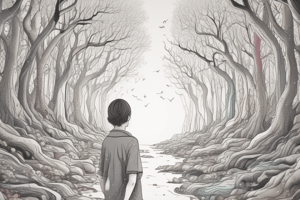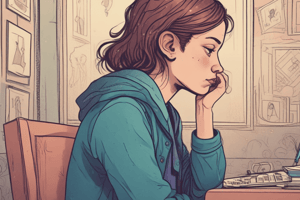Podcast
Questions and Answers
What is a potential long-term belief a child with emotional numbing may develop?
What is a potential long-term belief a child with emotional numbing may develop?
- I will achieve all my dreams.
- I will always be happy and social.
- I will live to see my dad when he comes back.
- I will not live to see my dad when he comes from his trip. (correct)
Which of the following treatments is usually considered the first choice for childhood anxiety disorders?
Which of the following treatments is usually considered the first choice for childhood anxiety disorders?
- Benzodiazepines
- Behavioral therapy only
- Selective Serotonin Reuptake Inhibitors (SSRIs) (correct)
- None of the above treatments
What is a common symptom associated with hyperarousal in children experiencing anxiety?
What is a common symptom associated with hyperarousal in children experiencing anxiety?
- Severe lethargy during the day
- Difficulty relaxing and disrupted sleep (correct)
- Constant happiness and joy
- Feeling overly energized
In which situation is behavioral therapy alone usually considered sufficient for treating anxiety disorders?
In which situation is behavioral therapy alone usually considered sufficient for treating anxiety disorders?
What impacts the prognosis of a child experiencing anxiety disorders?
What impacts the prognosis of a child experiencing anxiety disorders?
What is a common manifestation of anxiety disorders in children?
What is a common manifestation of anxiety disorders in children?
What can contribute to the worsening of anxiety disorders in children?
What can contribute to the worsening of anxiety disorders in children?
Which physical symptom is NOT commonly associated with generalized anxiety disorder?
Which physical symptom is NOT commonly associated with generalized anxiety disorder?
How is generalized anxiety disorder primarily characterized in children?
How is generalized anxiety disorder primarily characterized in children?
What psychological condition can occasionally be confused with generalized anxiety disorder due to overlapping symptoms?
What psychological condition can occasionally be confused with generalized anxiety disorder due to overlapping symptoms?
What type of behavior might children with social phobia exhibit?
What type of behavior might children with social phobia exhibit?
In which context may anxiety in children often manifest through somatic complaints?
In which context may anxiety in children often manifest through somatic complaints?
What is a potential trigger for social phobia in children?
What is a potential trigger for social phobia in children?
What is the primary treatment approach for children with severe separation anxiety disorder?
What is the primary treatment approach for children with severe separation anxiety disorder?
Which age group is most likely to experience separation anxiety disorder?
Which age group is most likely to experience separation anxiety disorder?
How can a mother's anxiety impact her child?
How can a mother's anxiety impact her child?
What is a common symptom that may appear alongside separation anxiety disorder in children?
What is a common symptom that may appear alongside separation anxiety disorder in children?
What characterizes obsessive-compulsive disorder (OCD) in children?
What characterizes obsessive-compulsive disorder (OCD) in children?
What syndrome should be considered in children with sudden onset severe OCD-like symptoms?
What syndrome should be considered in children with sudden onset severe OCD-like symptoms?
Which type of fears are commonly expressed as obsessions in OCD?
Which type of fears are commonly expressed as obsessions in OCD?
What impact does missing school have on children with separation anxiety disorder?
What impact does missing school have on children with separation anxiety disorder?
What is a key characteristic of compulsive behaviors in children?
What is a key characteristic of compulsive behaviors in children?
How are compulsive behaviors sometimes logically connected to obsessions?
How are compulsive behaviors sometimes logically connected to obsessions?
What differentiates panic disorder from agoraphobia?
What differentiates panic disorder from agoraphobia?
Which of the following is a symptom of acute stress disorder (ASD)?
Which of the following is a symptom of acute stress disorder (ASD)?
What is a common cause of posttraumatic stress disorder (PTSD) in young children?
What is a common cause of posttraumatic stress disorder (PTSD) in young children?
What type of symptoms do panic attacks involve?
What type of symptoms do panic attacks involve?
How does reassurance seeking manifest in children with obsessive behaviors?
How does reassurance seeking manifest in children with obsessive behaviors?
What is a possible outcome of not all children exposed to trauma developing PTSD?
What is a possible outcome of not all children exposed to trauma developing PTSD?
Flashcards
Emotional Numbing
Emotional Numbing
A group of symptoms in children that may occur after a traumatic event, including a lack of interest in activities, social withdrawal, and feeling emotionally numb.
Hyperarousal
Hyperarousal
Symptoms of heightened anxiety and alertness, such as difficulty relaxing, sleep disturbances, and frequent nightmares.
Behavioral therapy
Behavioral therapy
A type of therapy that helps children gradually face their fears by exposing them to anxiety-provoking situations in a controlled and safe manner.
Selective Serotonin Reuptake Inhibitors (SSRIs)
Selective Serotonin Reuptake Inhibitors (SSRIs)
Signup and view all the flashcards
Benzodiazepines
Benzodiazepines
Signup and view all the flashcards
Separation Anxiety Disorder
Separation Anxiety Disorder
Signup and view all the flashcards
Separation Anxiety (Normal)
Separation Anxiety (Normal)
Signup and view all the flashcards
School Refusal in Separation Anxiety Disorder
School Refusal in Separation Anxiety Disorder
Signup and view all the flashcards
Separation Anxiety Disorder vs. Social Phobia
Separation Anxiety Disorder vs. Social Phobia
Signup and view all the flashcards
Obsessive-Compulsive Disorder (OCD)
Obsessive-Compulsive Disorder (OCD)
Signup and view all the flashcards
Pediatric Autoimmune Neuropsychiatric Disorders Associated with Streptococcal Infections (PANDAS)
Pediatric Autoimmune Neuropsychiatric Disorders Associated with Streptococcal Infections (PANDAS)
Signup and view all the flashcards
Obsessions in OCD
Obsessions in OCD
Signup and view all the flashcards
Treating PANDAS
Treating PANDAS
Signup and view all the flashcards
Compulsions
Compulsions
Signup and view all the flashcards
Obsessions
Obsessions
Signup and view all the flashcards
Reassurance Seeking
Reassurance Seeking
Signup and view all the flashcards
Panic Disorder
Panic Disorder
Signup and view all the flashcards
Agoraphobia
Agoraphobia
Signup and view all the flashcards
Acute Stress Disorder (ASD)
Acute Stress Disorder (ASD)
Signup and view all the flashcards
Posttraumatic Stress Disorder (PTSD)
Posttraumatic Stress Disorder (PTSD)
Signup and view all the flashcards
Traumatic Events
Traumatic Events
Signup and view all the flashcards
Anxiety Disorders in Children
Anxiety Disorders in Children
Signup and view all the flashcards
Etiology of Anxiety Disorders
Etiology of Anxiety Disorders
Signup and view all the flashcards
School Refusal or School Phobia
School Refusal or School Phobia
Signup and view all the flashcards
Generalized Anxiety Disorder (GAD)
Generalized Anxiety Disorder (GAD)
Signup and view all the flashcards
Social Phobia
Social Phobia
Signup and view all the flashcards
Distinguishing GAD from ADHD
Distinguishing GAD from ADHD
Signup and view all the flashcards
Somatic Complaints as Anxiety Manifestations
Somatic Complaints as Anxiety Manifestations
Signup and view all the flashcards
Parental Anxiety and Child Anxiety
Parental Anxiety and Child Anxiety
Signup and view all the flashcards
Study Notes
Anxiety Disorders in Children
- Approximately 10-15% of children experience an anxiety disorder during childhood.
- A defining characteristic of anxiety disorders is a persistent state of fear or worry that significantly impairs a child's normal functioning, disproportionate to the situation.
Etiology of Anxiety Disorders
- The etiology of anxiety disorders has a genetic basis, significantly influenced by psychosocial experiences.
- Heritability is polygenic, with only a limited number of specific genes identified.
- Anxious parents often have anxious children, potentially exacerbating the child's challenges.
- In 30% of cases, treating parental anxiety alongside the child's can be beneficial.
Symptoms, Signs, and Diagnosis
- The most common presentation is school refusal ("school phobia").
- Some children explicitly express their worries (e.g., "I'm worried I won't see you again").
- Many children express their distress through somatic complaints (e.g., stomachaches).
Generalized Anxiety Disorder (GAD)
- GAD is a persistent state of heightened anxiety characterized by excessive worrying and fear.
- Physical symptoms can include tremors, sweating, multiple somatic complaints, and exhaustion.
- GAD can be misdiagnosed as attention-deficit/hyperactivity disorder (ADHD) due to overlapping symptoms. A key difference is that children with GAD usually have more significant anxieties.
Social Phobia
- Social phobia involves persistent fear of humiliation, ridicule, or embarrassment in social situations.
- School refusal is often an initial sign, particularly in adolescents.
- Symptoms are often somatic in nature (e.g., "My stomach hurts").
- In severe cases, avoidance of social interaction and situations can be extreme.
- Behavioral therapy is crucial for treatment.
Separation Anxiety Disorder
- Separation anxiety disorder involves a persistent, intense, and inappropriate fear of separation from a primary attachment figure (usually the mother).
- Separation anxiety is normal in early childhood (ages 6-24 months) but resolves as children develop object permanence.
- In some cases, separation anxiety persists or returns later, becoming clinically significant.
- Often co-occurs with the mother's own anxiety symptoms, creating a reciprocal pattern.
Symptoms and Signs of Anxiety Disorders
- Separation anxiety frequently presents as school refusal.
- Anxiety can be compounded by parental anxiety symptoms.
- Children often exhibit patterns of repetitive requests for reassurance.
- Somatic complaints are frequent expressions of anxiety.
Obsessive-Compulsive Disorder (OCD)
- OCD is characterized by obsessions (recurring thoughts) and/or compulsions (repetitive behaviors).
- These symptoms significantly interfere with academic and social functioning.
- Most cases of OCD do not have a clear etiology, but PANDAS (pediatric autoimmune neuropsychiatric disorder associated with streptococcus) is a possible link in some cases.
- Early antibiotic treatment for PANDAS may be beneficial in preventing or reducing long-term effects.
Panic Disorder and Agoraphobia
- Panic disorder is characterized by recurrent and frequent panic attacks (at least once a week).
- Panic attacks are brief episodes (around 20 minutes) of intense physical or cognitive symptoms.
- Agoraphobia involves a persistent fear of being trapped or unable to escape from certain situations or places.
- Agoraphobia often co-occurs with panic disorder.
- Diagnosis necessitates ruling out medical causes for somatic symptoms.
Acute and Post Traumatic Stress Disorders (PTSD)
- Acute Stress Disorder (ASD) is characterized by a brief (approximately one month) period of intrusive experiences and anxiety following a traumatic event.
- Posttraumatic Stress Disorder (PTSD) involves longer-lasting (more than one month) intrusive recollections of a traumatic event.
- Not all children exposed to trauma develop ASD or PTSD. Vulnerability and temperament play a role.
- Trauma experienced by young children sometimes involves domestic violence.
Signs and Symptoms of Anxiety Disorders
- "Emotional numbing" describes symptoms including lack of interest, social withdrawal, and feeling numb.
- Hyperarousal is difficulty relaxing.
- Sleep disruption, including nightmares, can be common.
- Prognosis is influenced by trauma severity, associated injuries, and resilience in the child and family.
Prognosis and Treatment
- Prognosis for anxiety disorders depends on the severity, the availability of effective treatment, and the child's resilience.
- Treatment often involves behavioral therapy, focusing on exposure techniques to gradually desensitize the child to anxiety-provoking situations.
- Selective Serotonin Reuptake Inhibitors (SSRIs) are commonly used if drug therapy is necessary.
- Benzodiazepines are sometimes utilized but are often less preferred due to potential negative effects.
- In some cases, a combination of behavioral and drug therapies is needed.
Studying That Suits You
Use AI to generate personalized quizzes and flashcards to suit your learning preferences.




